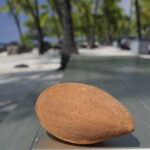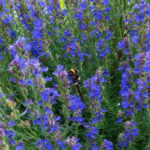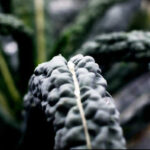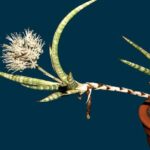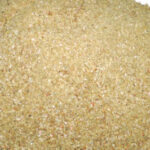The squash vine borer is a common pest across North America. While in some areas this moth is less prevalent than other pests, it’s particularly damaging. That means identifying moths and squash vine borer larvae and controlling them is important, especially if you want to maintain a healthy squash plant.
Personally, they’re one of my least favorite garden pests. While aphids and thrips come in large numbers, SVB comes singly. If I’m not vigilant and don’t look out for the moths and their eggs, I can lose an entire vine. So, naturally, I’m pretty averse to the thing. And I do my best to prevent and control them.
Here, we’ll cover basic info about the borer, discuss its life cycle, and discuss ways to prevent and treat its damage in a garden. All of this is done in hopes that you’ll employ the advice here in your own garden, and have a lovely, healthy, hearty squash harvest as a result.
Subscribe to the Epic Gardening Podcast on Squash vine borers, vine borers, squash borers, squash stem borer, etc. Scientific Name(s) Melittia cucurbitae, Melittia calabaza, Melittia gloriosa, Melittia grandis Family Sesiidae Origin North America, parts of South America & Mexico, southeastern Canada Plants Affected Cucurbitae species of squash/gourd/pumpkin Common Remedies Diatomaceous earth, aluminum foil wraps, neem oil to kill eggs, etc.
The squash vine borer is the larvae of the clearwing Melittia moth. The moth itself is often confused with bees or wasps as it looks similar, and has distinctly red or red-orange coloring on a black body. While the squash vine borer moths don’t directly harm our squash plants, the larvae feed ravenously from within the squash plant stem. They will burrow right in devour the soft tissues inside, causing wilting and eventual plant death. Nobody wants to lose their prize squash plants, especially during the summer!
A Word On Squash Bugs
Before we dive into squash vine borer species, it should be noted that borers are not the same as the squash bug (Anasa tristis). We have a great piece on how to handle squash bugs, and while some treatments are similar, they aren’t identical! These are actually a species of true bug that feeds on the leaves of cucurbit vines. Their eggs can be confused for SVB eggs, though, as they look similar and are laid on stems and leaf stalks.
Squash vine borer adults fly during the day and look a lot like wasps. They are about ½ inch long and have an orange to red abdomen with black dots running down the center. They have two pairs of wings – a dark metallic green pair on top of a clear pair. Often the hind wings are invisible when the moths are at rest because they fold under.
Vine borer larvae are white or cream-colored with a brown head. They grow to almost an inch in length by the time they are ready to pupate and metamorphose into an adult moth. They are sometimes called squash worms. The squash vine borer moth eggs are laid in clusters and are brown, flat, and less than 1/25 inch long.
Types of Squash Vine Borer
There are four species of squash vine borer: Melittia calabaza and Melittia cucurbitae, or the southwest squash vine borer and squash vine borer, respectively. Then there is Melittia gloriosa and Melittia grandis. The most damaging of these are Melittia calabaza and Melittia cucurbitae. These are the ones you’re most likely to find in your cucurbit crops. The difference between the two is that Melittia calabaza has an orange second abdominal segment, and Melittia cucurbitae has dark olive green on its second abdominal segment.
Life Cycle of Squash Vine Borer
Sometime in early summer to mid-summer, the adult vine borer moth emerges from the cocoon in the ground where it pupates over winter. Within days, the moths mate and then lay eggs. A moth will lay tight clusters of eggs on a specific plant, then move on to the next one. A single moth can, in this way, become destructive to all the squash plants in a garden.
The small brown eggs can be found on low leaf stems, the squash leaf, or on the main plant stems, and occasionally on the underside of leaves. However, most often I find them on the main squash stems very close to the soil level. A week later, the eggs hatch and larvae quickly bore small holes into the main stem of their host plant to begin feeding. Inside, it eats tender plant tissues and blocks water that flows along the stem. As a result, the plants begin to wilt and eventually die.
The larvae will feed inside their host plant for 4-6 weeks, then exit the stem and burrow deep into the soil to pupate. Cocoons hide within the soil until the following year when the next batch of squash vine borers emerges. Female moths only produce one generation each year. However, a field that has been attacked in the past is likely to have problems in subsequent years, as pupae hide in the soil below. Tilling the soil turns the cocoons up to the surface and allows birds access to juicy morsels, but often they’re not all discovered.
Identifying Squash Vine Borer Damage
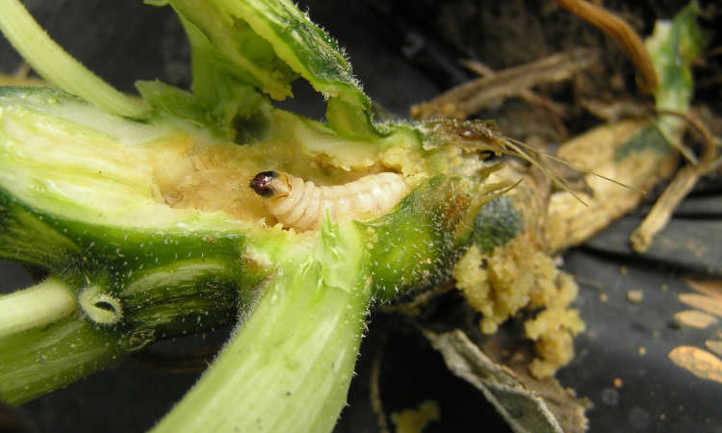
To ensure you’re dealing with this garden pest, consider the type of damage your squash vine is displaying. The first sign of attack is wilting vines. While this is a common sight in a hot summer garden, look more closely at the vine to determine if other signs are present. Look for small holes that have larval frass around their margin. This is caterpillar poop from larval feeding. If the stem rots and gets mushy, open the stem. It’s possible sometimes to locate the larvae within the stem and kill it before it gets too far.
Which Squash Do Squash Vine Borers Like?
Cucurbita maxima is their first choice. This species includes varieties such as Hubbard squash, buttercup, Lakota squash, Jarrahdale pumpkin, and a few others. These are mostly winter squash varieties. If there aren’t Cucurbita maxima plants nearby, the next best squash vine is Cucurbita pepo. These include summer squash and are the most popular of summer cucurbit varieties. Included in this species are most pumpkins, zucchini, acorn squash, straightneck or scallop squashes, and more.
The least susceptible species of squash is Cucurbita moschata. This species tends to have more rigid vines. While the borers can attack them, they’ll usually head towards easier targets. In this species, the most popular is the butternut squash, but there are many more including some varieties of crookneck squash. Interestingly, some will place eggs on the stems of other plants that are not cucurbits, like celery.
Controlling Squash Vine Borer
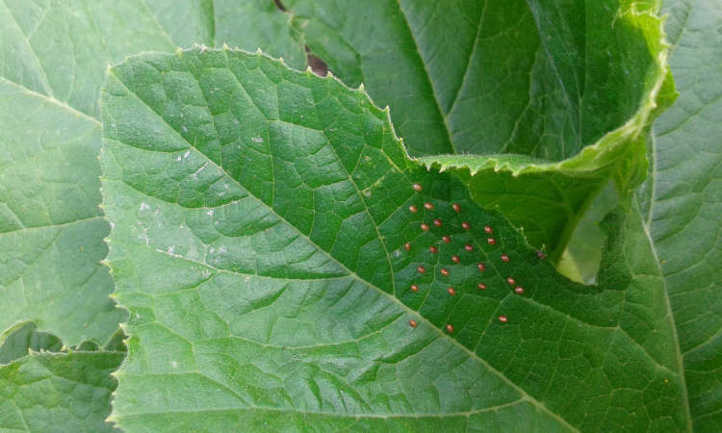
It can be tricky to eliminate these pests. Once you see the adult, it’s already laid eggs. You can kill off individual moths, but once the vine borer gets into the plant, most sprays won’t work. Don’t panic, though! There are ways to handle these little devious pests.
Cultural Control of Squash Vine Borer
Environmental controls are necessary as well to combat these tricky little bugs. One of the best options is to add beneficial nematodes to your beds. These microscopic soil-dwellers attack and destroy the pupae of borers along with a variety of other insects. The Steinernema-species nematodes, especially Steinernema feltiae, are the most effective.
There are two types of traps that are also effective: colored and pheromone traps.
Colored traps include yellow sticky traps and yellow bowl water traps. The color yellow draws in the adult squash borer as they normally look for yellow squash blossoms. The sticky traps cause them to get stuck and die. Yellow bowls full of water cause them to drown. Pheromone traps lure adults by scent as well as their color, enticing them to get close. Once they do, they get stuck on the sticky surface of the trap and die there.
Till the soil after the season ends, once your squash plants are done producing. Squash vine borer larvae do not go too deep in the soil to pupate and are usually only in the first few inches. Tilling brings them to the surface and makes them susceptible to the elements or to hungry birds. Finally, even if your plants do get infested, practice good garden maintenance. Remove dead plants before the vine borers reach maturity. Don’t compost those plants. Instead, destroy them entirely to kill the larvae.
Organic Removal of Squash Vine Borer
Diatomaceous earth can prevent egg-laying by SVB moths. This prevents larval feeding and development of adult squash vine borer moths. However, diatomaceous earth no longer works in moist soil or wet plants, so while you can dust it on all surfaces of the plant, be sure the plant doesn’t have water on it. Reapply diatomaceous earth after rainy weather, once the plant has dried again.
If eggs hatch and larvae bore inside your vine, conduct surgery to kill them off. Find the hole, and look closely at it to determine the direction the borer went. With a sterile razor blade or sharp knife, make an incision no deeper than halfway into the stem. Find the borer and use a toothpick or needle to kill it. Surgical methods can be risky for the plant, so if you do opt to do this, be sure to bury the wounded stem beneath the soil’s surface. It may send out new roots from that area, and covering it should help protect against some bacterial or fungal diseases.
Insecticidal Control of Squash Vine Borer
Neem oil smothers the eggs. Since it protects against several other pests and diseases, including powdery mildew, this is a great overall preventative method as well. If you see squash vine borer adults, you can use Bacillus thuringiensis to eliminate them and their eggs. Spray forms or powder forms of Bt will protect your plant against infestation.
A spinosad spray can also be effective at killing off adult moths and their eggs. Apply these in intervals of 7 to 10 days, at least a week before harvesting, especially if developing fruit are present on the plant. Neither bacillus thuringiensis nor spinosad sprays to the exterior of the plant will not have any effect on borers already inside the vine, so surgery may be your best line of defense if squash vine borers have already made their way into the stem of your squash plants.
There is another way to use liquid Bt to deal with borers: by injecting Bt in the vine directly. Use a 3cc hypodermic needle from a medical supply store, and sterilize the needle’s tip in a mix of half bleach and half water. Then fill the syringe with 1cc of liquid Bt. About an inch and a half above the soil line, carefully insert the needle into the stem about halfway. Then slowly press down the plunger to fill the lower stem with Bt. Repeat these injections every 7-10 days to keep plants free of squash vine borers.
If you can already see entrance holes where larvae bore, inject the stem about one inch above the hole. The Bt spray will drip down onto the borer inside and kill it off. After every injection, sterilize the needle again. To do this, place the needle into your bleach/water mix and draw bleach and water into the plunger, then press it back out. Repeat this 2-3 times, ensuring you completely submerge the needle. Sterilization prevents the spread of plant diseases.
Another mode of treating squash vine borers is by running a slender wire down the inside of the vine from the borer’s entrance hole to figure out where the borer is. Then inject above that point. Use the wire to stab the borer too, but this may or may not always squash vine borers, whereas Bt does. Finally, weekly applications of a chemical spray do work. However, chemical controls are risky to your pollinator insects, so you’ll have to determine if this choice is right for you. If you do opt to use chemicals, common ones used include carbaryl, permethrin, bifenthrin, and esfenvalerate. Remember to use an integrated pest management strategy to cover all your bases. And avoid spraying multiple chemicals on your plants at once, unless you know it’s ok to do so. The best way to determine that is to read the label on your insecticides carefully.
Squash Vine Borer Prevention
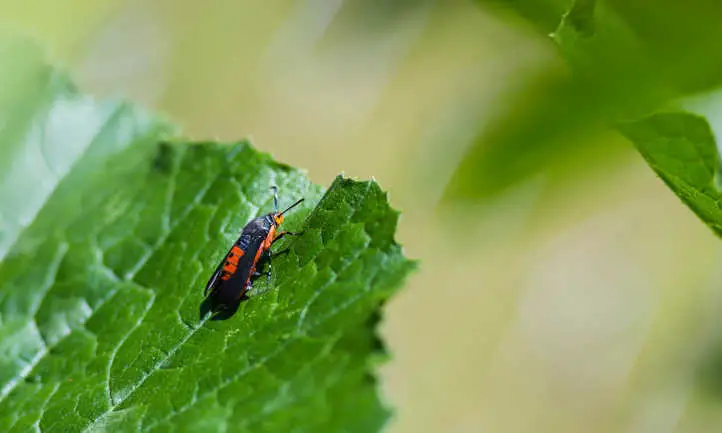
Now that we’ve discussed organic methods of control, and insecticidal controls, let’s talk about preventing squash vine borers. Wrap the stem base in aluminum foil when you plant squash. Don’t extend down below the soil line, but cover the stem itself with foil. This prevents an adult squash vine borer from getting into the stem in the first place. Subsequently, wrap any new growth to prevent squash vine borers that may be attracted to stems.
Floating row covers are effective if you didn’t have squash in those beds the year immediately before. Placing a floating row cover over a new bed that isn’t colonized with overwintering squash vine borers can help keep the adults from laying eggs on your plants. If you did plant other cucurbits in that spot last growing season, floating row covers aren’t as effective. Instead, use a row cover for newly grown crops. Remember to choose a row cover that allows in light and moisture. Remember you will need to hand-pollinate female flowers if you are using row covers that block access by pollinators. To do this, take a male flower, and remove all the petals. Then rub the tip of the male flower on the stigma of the female flower.
Crop rotation is essential for combatting squash vine borers. Since squash vine borers place eggs in the soil beneath the plants, moving your plants to a new bed every year can help prevent their return. Since they only have one generation per year, you can simply outwait them and plant squash again sometime in late July. This keeps it safe from squash vine borers, as they have already done their business and disappeared.
If you’re planting multiple types of squash, consider trap cropping with one or two plants of another squash species. If you’re growing Cucurbita pepo plants like zucchini, or summer squash, consider planting a couple of Cucurbita maxima plants nearby. The squash borers will go after the C. maxima plants first. Finally, planting resistant species is one of the easiest ways to avoid dealing with borers. Species like Cucurbita moschata (like butternut squash, or winter squash plants) tend to be much more resistant to these pests than other squash plants.
Frequently Asked Questions
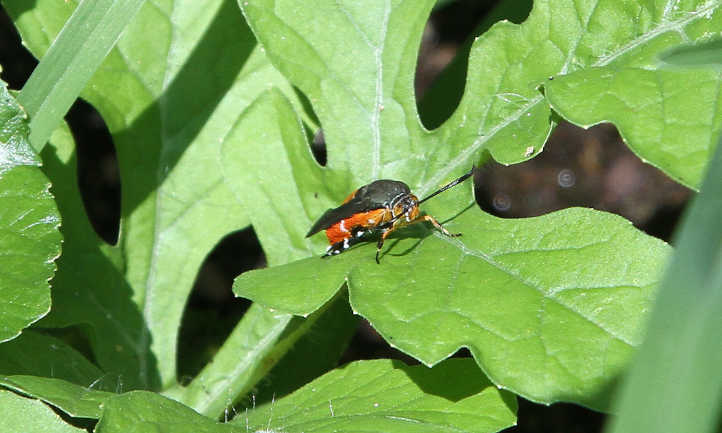
Q: Can squash recover from vine borers?
A: Especially with healthy, prolific vines, they can. If you’ve managed to locate and kill the larvae in affected plants, you’ll have a much easier time dealing with the damage caused.
Q: What time of day are squash vine borers active?
A: The moth flight occurs during the day, distinguishing it from its nocturnal counterparts.
Q: Does neem oil work on squash vine borers?
A: While it doesn’t work on squash vine borer moth or the larvae inside stems, it does smother eggs and prevent other diseases.
Q: What month do vine borers lay eggs?
A: The adults lay eggs on stems in early to mid-summer. Just before this use aluminum foil to prevent them from laying eggs on the main stem of your plants.
Q: Are other plants susceptible?
A: While they have been known to attack cucumbers, melons, and even celery if they have no squash at hand, they tend to avoid other plant types. For some reason, the tasty innards of summer or winter squash and pumpkins are the most appealing!



